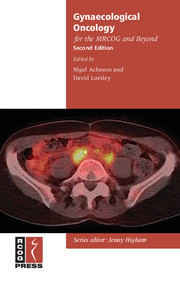Book contents
- Frontmatter
- Contents
- About the authors
- Preface
- Introduction to the second edition
- Abbreviations
- 1 Basic epidemiology
- 2 Basic pathology of gynaecological cancer
- 3 Preinvasive disease of the lower genital tract
- 4 Radiological assessment
- 5 Surgical principles
- 6 Role of laparoscopic surgery
- 7 Radiotherapy: principles and applications
- 8 Chemotherapy: principles and applications
- 9 Ovarian cancer standards of care
- 10 Endometrial cancer standards of care
- 11 Cervical cancer standards of care
- 12 Vulval cancer standards of care
- 13 Uncommon gynaecological cancers
- 14 Palliative care
- 15 Emergencies and treatment-related complications in gynaecological oncology
- Appendix 1 FIGO staging of gynaecological cancers
- Index
15 - Emergencies and treatment-related complications in gynaecological oncology
Published online by Cambridge University Press: 05 August 2014
- Frontmatter
- Contents
- About the authors
- Preface
- Introduction to the second edition
- Abbreviations
- 1 Basic epidemiology
- 2 Basic pathology of gynaecological cancer
- 3 Preinvasive disease of the lower genital tract
- 4 Radiological assessment
- 5 Surgical principles
- 6 Role of laparoscopic surgery
- 7 Radiotherapy: principles and applications
- 8 Chemotherapy: principles and applications
- 9 Ovarian cancer standards of care
- 10 Endometrial cancer standards of care
- 11 Cervical cancer standards of care
- 12 Vulval cancer standards of care
- 13 Uncommon gynaecological cancers
- 14 Palliative care
- 15 Emergencies and treatment-related complications in gynaecological oncology
- Appendix 1 FIGO staging of gynaecological cancers
- Index
Summary
Introduction
Gynaecological cancers are more common in postmenopausal and elderly women. Most treatments in gynaecological oncology are instituted as elective procedures but acute presentations are not uncommon. Emergencies in gynaecological oncology are influenced by the site of cancer, stage of disease, presence of associated comorbidities and the treatment received. Emergencies can be medical or surgical.
Cancer-related emergencies
COMPLICATIONS RELATED TO ADNEXAL MASSES
Acute abdominal pain
The causes of acute abdominal pain associated with an adnexal mass are torsion, infarction, rupture and haemorrhage. Twisting of the ovarian pedicle results in torsion of the cyst causing a reduced blood supply, which leads to infarction and ischaemic pain. While smaller dermoid cysts are notorious for undergoing torsion, large tumours filling the entire pelvis rarely have space to undergo torsion. Infarction can also be caused by increasing size in a solid tumour resulting in diminished central blood supply. Rapidly growing tumours can develop internal haemorrhage by stretching and tearing of the feeding blood vessels or rupture of the cyst wall with bleeding into the peritoneal cavity.
Presentation
Patients usually present with sudden onset of abdominal pain radiating to the back and the thighs. Eventually, symptoms of peritonism (guarding, rigidity, rebound) and haemodynamic instability will develop with raised inflammatory markers and anaemia.
Keywords
- Type
- Chapter
- Information
- Gynaecological Oncology for the MRCOG and Beyond , pp. 229 - 244Publisher: Cambridge University PressPrint publication year: 2011

